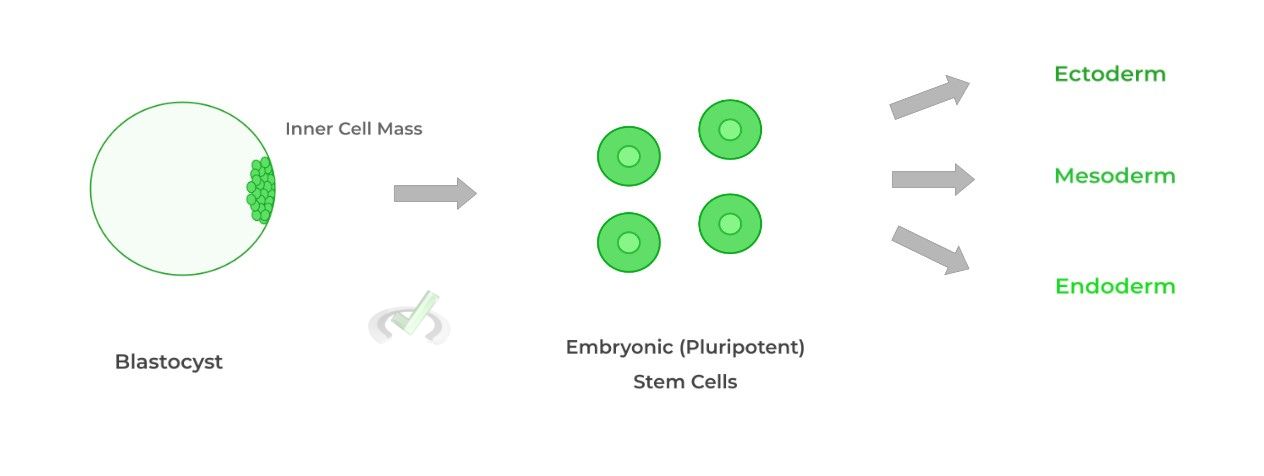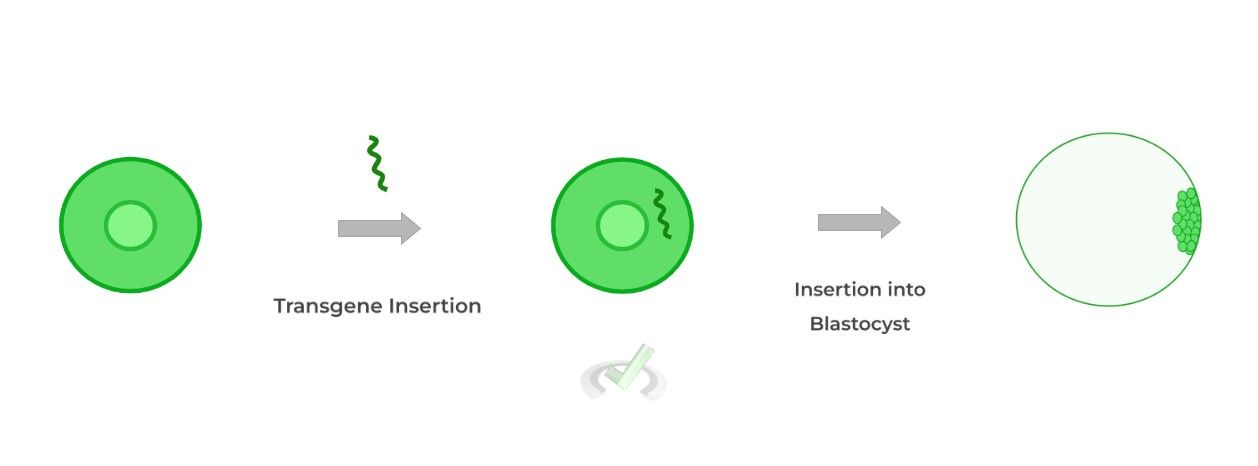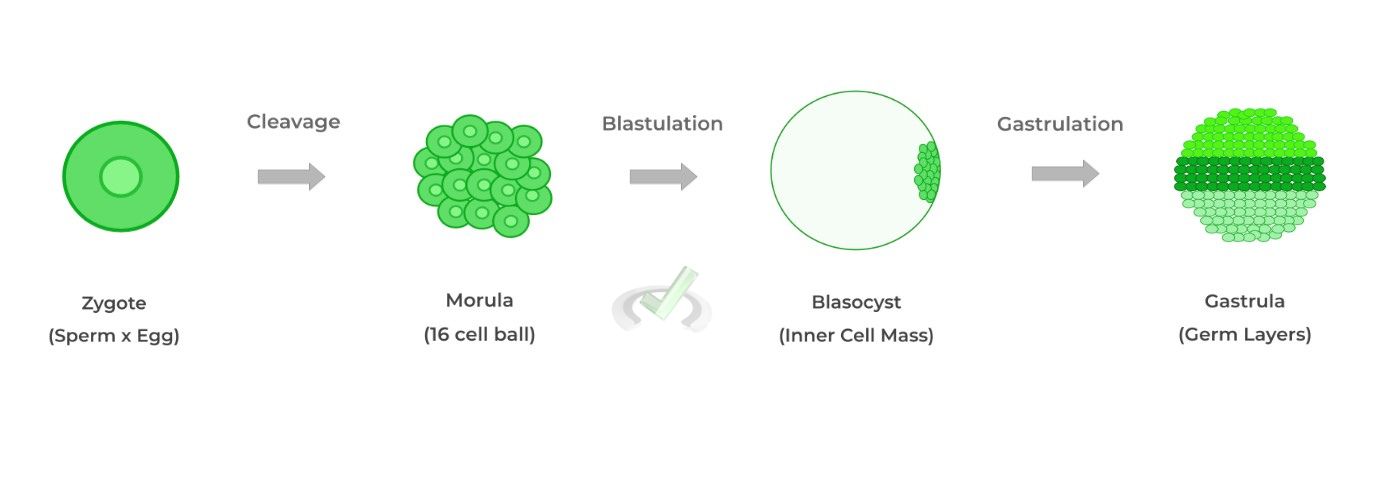I. What are Embryonic Stem Cells?
Though you’ve definitely heard them in multiple contexts such as in school, on the news, in debates, stem cells are without a doubt one of most incredible discoveries in organism reproductive physiology and also plays its part in scientific research.
We have another article on stem cells explaining them from a basic physiological standpoint in reproduction, but we want now to highlight the research and experimental applications of these cells and how they can be used to study diseases!
Nevertheless, there’s undeniable debate and controversy that partners with topics such as these, which we’ll also cover in another article. For now, let’s get down to the basics of embryonic stem cells and their implications in scientific research!
II. Types of Stem Cells
As a quick refresher of basic stem cell content, there are 3 types of stem cells: 1) totipotent, 2) pluripotent, and 3) multipotent stem cells. We’ll primarily highlight pluripotent stem cells as embryonic stem cells are classified into this category of stem cells.
A. Pluripotency of Embryonic Stem Cells
Recall that pluripotent stem cells are the “middle most” in terms of differentiation potential, where they can develop into any cell type except extraembryonic cells, such as the placental cells.
In other words, they are able to differentiate into any of the cells within the 3 germ layers: ectoderm, mesoderm, and endoderm.
These embryonic stem cells are primarily harvested from the inner cell mass (ICM) of the blastocyst, which is essentially a ball of cells with a fluid filled inside.

From here, we can actually use the pluripotent, embryonic stem cells to specialized mice we can use to study diseases as we’ll detail below!
B. Transgenic Mice
Suppose we want to introduce a disease, causing gene into an organism, such as a cancerous oncogene, to see how it would result in that disease. We can first insert the transgene (the “transferred gene” into the genome of the embryonic stem cells.
The embryonic stem cells are then selected for those that have the gene and then reinjected into a developing blastocyst.
Finally the blastocyst is implanted into a pseudopregnant mice to allow for growth of the embryo into mice offspring. Pseudopregnant is a term to describe female mice that are physiologically similar to an actually pregnant mice, but lack a fetus!

Because the blastocyst contains the reinserted embryonic stem cells with the transgene, the developing offspring cell’s will also have the transgene!
However, it’s important to note that a more proper term to describe the resulting offspring is chimera because there are 2 types of cells within the blastocyst’s inner cell mass: 1) the regular and 2) the transgenic embryonic stem cell.
As a result, a chimeric organism is formed where some cells DO HAVE the transgene and some DO NOT have the transgene. It’s at this point that further crossing is needed to obtain a mice homozygous for the transgene.
C. Knockout Mice
In this case, researchers want to study a disease that results from the lack of a gene. Hence, we can use knockout mice, which have cells that have the gene of interest “knocked out”.
To again use a cancer analogy, researchers may want to study the progression of cancer in knockout mice which lacks the p53 gene!
Luckily, the process for generating knockout mice is exactly the same as generating transgenic mice; however, in this case, we engineer the embryonic stem cells where the gene of interest is lacking within the cells.III. Bridge/Overlap
As we mentioned the blastocyst in the context of the material above, it may be helpful just to get a brief, succinct overview of the developmental stages of an embryo!
I. Review on Embryo Development
Of course, the development of the entire organism originates from the zygote, a diploid cell formed from the fertilization of an egg with a sperm cell. The zygote then undergoes a series of cell divisions, called cleavage, to create a 16 ball structure called a morula.
The morula then undergoes blastulation, producing the blastocyst, which consists of the inner cell mass (ICM), a fluid filled cavity called the blastocoel, and the trophoblast cells, which compose the outer portion of the blastocyst.
The blastocyst then enters gastrulation, where the ICM is converted into the gastrula, which leads to the development of the 3 germ layers!
Let’s now highlight some of the differences between the structures in terms of stem cells. The morula is composed of totipotent stem cells, which have the highest potential for cell differentiation as they can differentiate into placental cells and the cells of the 3 germ layers.
As mentioned above, embryonic stem cells from the ICM are pluripotent, a more limited version of totipotent cells.
Finally, the cells within the gastrula are multipotent, as they can still differentiate into many cells, but are limited to a certain germ layer. For example, cells within the mesoderm can differentiate into cardiac and skeletal muscle cells, but cannot differentiate into neurons.IV. Wrap Up/Key Terms
Let’s take this time to wrap up & concisely summarize what we covered above in the article!
A. Pluripotency of Embryonic Stem Cells
Compared to totipotent and multipotent stem cells, pluripotent stem cells are the “middle most” in terms of differentiation potential.
The pluripotent, embryonic stem cells are harvested from the inner cell mass (ICM) of the blastocyst, which can be used for a wide variety of research and medical applications!B. Transgenic Mice
This type of research mice have uptaken a foreign transgene, often a disease causing gene, in order to study the effects of that gene in disease progression.
We can use pluripotent, embryonic stem cells to generate these mice! After harvesting from the ICM, the transgene is uptaken by the stem cells.
After selecting for cells which have successfully uptaken and integrate the gene into the genome, the embryonic stem cells can be reinserted into blastocyst which can then be reimplanted into a pseudopregnant female mouse.
The resulting offspring will be a chimera as some cells will contain the transgene while others won’t as the ICM is composed of the normal and transgenic stem cells!C. Knockout Mice
This type of research mice actually have a gene of interest removed or inactivated, hence the term “knockout”. Likewise, it’s also helpful when studying the effects of gene inactivation on disease progression.
Luckily, the process for producing these types of mice with embryonic stem cells is exactly the same as for transgenic mice, except after embryonic stem cell harvesting, we engineer the stem cells in a way where a gene is inactivated or removed.
V. Practice
Sample Practice Question 1
Embryonic stem cells can differentiate into which of the following types of cells?
I. Neurons
II. Placental Cells
III. Cardiac Muscle
A. II only
B. III only
C. II and III
D. I and III
Ans. D
Recall that the embryonic stem cells are pluripotent, meaning they have the capacity to differentiate into cells from the 3 germ layers, but not extraembryonic, placental cells.
Sample Practice Question 2
A C228T mutation for the gene TERT, a subunit of telomerase, is shown to drastically increase and promote telomerase expression. Given this, which type of mouse would be best suited to study the effects of this mutation on cancer progression?
A. Transgenic Mice
B. Knockout Mice
C. Either Transgenic or Knockout Mice
D. Neither Transgenic of Knockout MIce
Ans. A
An important idea to realize is that this type of mutation is a gain of function mutation. We’re not taking away the function of the gene which is why knockout mice would be ineffective, rather, we’re curious to how this disease-causing gene can progress cancer growth.
Here, a transgene containing the C228T mutation can be inserted into embryonic stem cells which can then follow the same protocol and to generate transgenic mice with the C228T TERT mutation.







 To help you achieve your goal MCAT score, we take turns hosting these
To help you achieve your goal MCAT score, we take turns hosting these 





















 reviews on TrustPilot
reviews on TrustPilot